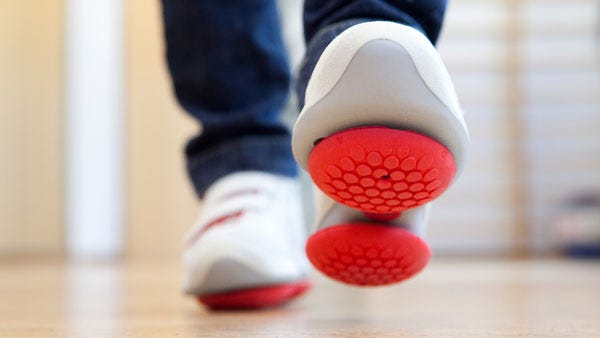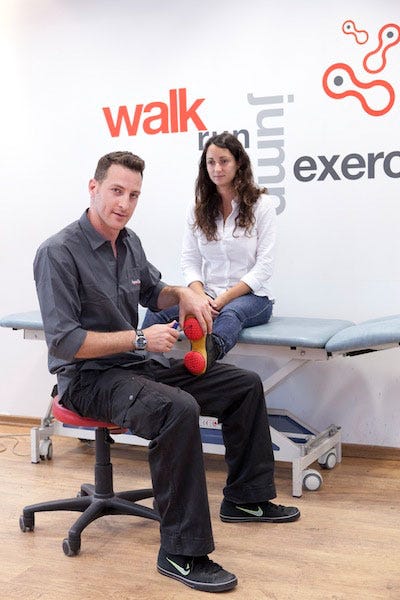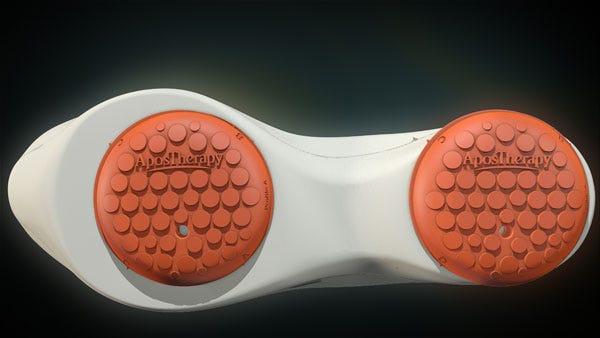How a Custom Shoe Maker Is Taking on the Orthopedics Industry
April 6, 2015
AposTherapy is debuting a foot-worn medical device in the United States after initially launching it in Israel, Singapore, and the United Kingdom.
Brian Buntz

While in medical school in Israel in the early 1990s, Amit Mor and Avi Elbaz wondered why the role of muscles wasn't emphasized more in orthopedic classes or in residency. "We learned about the bones, how to fix fractures, and implants. We studied the ligaments and cartilage. Nobody really ever talked much about the function of muscles, nerves, and gait," recounts Mor, who went on to found the company AposTherapy (New York City) in 2004 with Elbaz to help remedy the problem.
The company developed a foot-worn biomechanical device, now listed as a Class I medical device, designed to strengthen muscles supporting the joints in the legs while relieving pressure in the joints. It can be used for everything from arthritis treatment to helping patients recover from hip- or knee-replacement surgery. A number of patients are turning to the device, however, to help alleviate hip or knee pain to help them avoid hip- or knee-replacement surgery when that is a viable medical option.
The idea for the device came from the duo's extracurricular activities while in med school. "We were very active athletically and were very interested in biomechanics. Outside of class, we started reading about the way the muscles and the nerves control the joints," Mor says. "We started studying physiotherapy, biomechanics, engineering, and physics on our own. We came to understand how important muscles are in the rehabilitation for any orthopedic disorder."
They discovered how joint disorders in the hip and knee caused tightening of muscles around the joint, ultimately changing the gait and eventually more damage to the joints. Yet they reached the conclusion that the current way to treat the problem was less than satisfactory. "We wanted to develop a way to treat patients with hip and knee pain that would them to take their treatment home. We wanted it to be personalized for them and to be simple to help them comply," Mor says.
Introducing Instability to Build Strength
|
The shoe-worn devices are customized based on a patient's gait dynamics. |
The two physicians ended up inventing a device that can be fine tuned by specially trained physical therapists who use a computer analysis of the patient's gait. The patient is then free to take the device home and to ultimately wear it for an hour per day, going back every few months to have it recalibrated. "Medicine is going towards patient empowerment. It is the last frontier to be democratized. Traditionally, if you had a medical complaint, you go to a guy with a robe and a tie and he tells you what you should do.
Mor and Elbaz sought to address the problem by introducing a small amount of instability to the patient's joints when walking using pods attached to custom shoes. On each shoe, one pod is placed beneath the heel and the other below the forefoot. The patient begins wearing the shoes for a brief period of time, working up to wearing them one hour each day. "You need to get them to do hundreds of thousands of natural repetitions, so we understood that we had to bring it to the patient using the most common and intuitive interface we could--the shoe."
The custom designed shoe works as a whole biomechanical system that can be fine tuned to enable precise control over the forces generated in all of the planes of the body to bring them into a symmetrical alignment, Mor says. "Once we calibrate the patient, they have pain reduction and they walk better. We don't tell them to train or practice, just to wear the device for an hour each day."
While the patient wears the device, it promotes mild instability, or perturbation, eventually retraining the way the muscles control the ankle, knee, pelvis, and back. "There is motor learning. After using it, when people walk without it, the muscles have already learned to walk better."
Humble Beginnings
The roots of the company go back to 2000 when the two young doctors were doing postgraduate work in Israel. "No investor would invest a cent on two young doctors after the Dot-com Bubble burst. We started in the kitchen building prototypes because we couldn't afford a garage," he quips. "We used a cupcake tray for molding and made prototypes using polyurethane. We started treating students in the university with orthopedic conditions and the product proved to be successful."
By 2004, the two had founded a company out of a living-room-based office. "After five months, we had 17 employees. By our third year, we had more patients than the entire knee- replacement industry in Israel. Now, we have treated over 50,000 patients."
The company ultimately started selling its devices to patients who paid for them out of pocket. "Reimbursement came afterwards. We later got blanket coverage from the Israeli Ministry of Defense and major insurance companies," Mor says. "After our product was launched in the United Kingdom, we also got major insurance coverage there as well. We conducted a pilot clinical trial there and found that 85% of patients reported pain reduction within four or five weeks. 88% reported improvement in walking."
The pilot study was performed in collaboration with Bupa, the leading private insurance company in the United Kingdom.
The company later launched its product in Singapore and eventually relocated its headquarters to New York City. As the company continues to expand, it has collected data on the patients' gait, quality of life, and pain. "Now, we have one of the biggest databases like this in the world," Mor says. "This is where medicine is headed: monitoring outcomes rather than just telling stories and showing off studies. Payers, practitioners, and ACOs want to see the outcome. They want to know if your technology reduced patients' pain, improved function, and reduced unnecessary procedures."
Another important application for the technology is rehabilitation after joint replacement. "There has been a very big gap in the joint replacement industry--no real care for the muscles and neuromuscular control after a good surgery. This is going to become very important now in the era of monitoring and accountability," Mor adds.
|
The AposTherapy device features two pods that are custom-positioned on the bottom of a shoe. |
Helping Former Professional Athletes
Since the company was founded, it has worked with a significant number of athletes. Now, it even counts former NFL legend Bart Oates as its vice president of athletics. Oates has personally used the device as have a number of other former NFL players. "I have never seen people who are as badly damaged as football players," Mor said. "We have seen great results with them."
"A guy gets so many injuries when playing pro football, it is important for them to become proactive so they are not always in pain," Oates says. "Surgery is not always a cure all. It's nice to have a noninvasive treatment method that can either forestall or prevent surgery. A lot of former NFL athletes are looking for nonsurgical options and the AposTherapy device is a good example of that."
Oates says that, after wearing the device consistently for three or four months, he personally began to notice a significant improvement. "I felt a lot less pressure and a lot less stress in the joints. I can't say it is 100% better but I have noticed a significant improvement. It varies a lot depending on the user, but it works for anyone with back, knee, or hip issues," he says.
When wearing the device, "you don't feel unstable at all even though you are working to balance on pods. It is not like you are teetering though. The instability is very small. And over time, the weight distribution on your joints will change," he says.
Refresh your medical device industry knowledge at BIOMEDevice Boston, May 6-7, 2015. |
Brian Buntz is the editor-in-chief of MPMN and Qmed. Follow him on Twitter at @brian_buntz.
Like what you're reading? Subscribe to our daily e-newsletter.
About the Author(s)
You May Also Like




